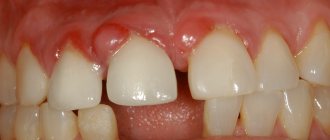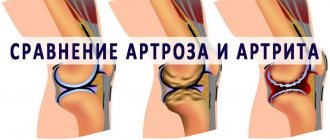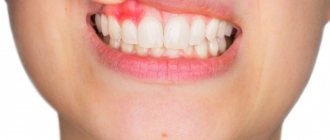From this article you will learn:
- what is periodontitis - symptoms, photos,
- anti-inflammatory therapy regimen,
- modern methods of treating periodontitis.
The article was written by a dentist with more than 19 years of experience.
Periodontitis is an inflammatory disease of the gums, which is accompanied by increasing destruction of the attachment of teeth to the bone tissue and soft tissues of the gums, which over time leads to tooth mobility. Periodontitis can appear in the area of only 1-2 teeth - in this case it is called localized, or it can be generalized (in the area of most teeth).
Most often, patients consult doctors with chronic generalized periodontitis, in which the gums of almost all teeth are inflamed. As a rule, most of these patients have a long history of self-medication of sore and bleeding gums (ie, symptoms of catarrhal gingivitis). Moreover, it is ineffective treatment or no treatment at all for gingivitis that leads to its gradual transformation into generalized periodontitis.
Periodontitis: generalized (Fig. 1) and localized (Fig. 2-3)
The causes of the localized form of periodontitis are local traumatic factors. This could be an overhanging edge of a filling or an artificial crown that injures the gums in the interdental space. The reason may also be “premature contacts” between the upper and lower teeth, which can appear either from natural causes or if the filling on the chewing surface or the crown is made a little higher than necessary.
Another common reason is when a dentist, when restoring a damaged tooth with a filling, incorrectly forms a contact point between the teeth in the interdental space. The lack of tight contact leads to constant food getting stuck in the interdental space and the development of inflammation. In the localized form (as opposed to the generalized form), symptoms of periodontitis occur only in teeth exposed to the traumatic factor.
Dental periodontitis - what is it?
Periodontium refers to the whole complex of tissues responsible for tooth retention: connective fibers, blood vessels, periodontium, gums, canals and jaw bone. Periodontitis is an inflammation of the gum tissue, which quickly affects the rest of the complex. As a result, the dentogingival connection is disrupted and the tooth falls out. Periodontitis is a very common disease that affects more than 95% of the world's inhabitants in various stages: from the rudimentary form of periodontitis to advanced, untreatable.
It is believed that most often the pathology manifests itself in men and women aged 30 to 40 years and in adolescents 16-18 years old. However, the disease can affect anyone, regardless of gender and age, if you do not monitor the condition of your oral cavity and postpone a visit to the dentist. Periodontitis can be treated only in the early stages; when it becomes chronic, no dentist, even the most modern, can cope with it, since the tissues have undergone irreversible changes.
Preventive measures
The most effective measure to prevent the onset of the disease is regular brushing of your teeth - twice a day, for at least two minutes. It is also recommended to rinse the mouth with special solutions after each meal. Brushing your teeth should always start from the upper jaw, first from the front and then from the back. It is important to use a soft toothbrush (or electric), gentle toothpaste and mouthwash.
If there is unevenness in the dentition, it is recommended to get braces or dentures at a young age.
Proper nutrition is also a preventative measure. It involves limited intake of carbohydrates and sweets, which lead to the development of the inflammatory process. It is recommended to add a lot of fruits and vegetables to your diet, which are rich in vitamins and microelements.
A healthy lifestyle, exercise, lack of stress, and an annual dental consultation minimize the risk of developing acute periodontitis.
Etiology of periodontitis
Periodontitis can be caused by various factors.
- Microbes.
The oral cavity of any person is inhabited by pathogenic microorganisms that do not cause harm if proper nutrition and hygiene are observed. But, if the patient constantly consumes carbohydrates and neglects to use dental floss, bacteria actively develop and gradually affect the enamel, dentin and reach the periodontal tissues. - Genetic predisposition.
If for many generations all family members have suffered from this disease, there is a high probability of adopting this predisposition. Heredity plays a big role in the development of gum periodontitis, even if a person carefully monitors hygiene and eats right. - Mechanical damage to the gums.
Tissue bruise due to negligence, an incorrect bite, in which increased pressure is applied to a specific area of the gum, or an oversized filling, due to which the tooth puts increased pressure on the gum and damages it. - Systemic diseases.
Dental diseases and periodontitis can cause pathologies not related to the oral cavity, such as vegetative-vascular dystonia, HIV, diabetes mellitus, hypertension and gastrointestinal diseases. - Autoimmune diseases.
Reduced immunity, disruption of the endocrine system, hormonal imbalances during pregnancy. - Poor quality dentist work.
Tissue damage during treatment, an unsuitable crown, incorrectly installed braces and other tissue injuries due to the fault of the doctor can provoke periodontitis.
Among the given factors are microbial causes of the development of periodontitis, and microbes are known to be transmitted from one person to another. So is periodontitis contagious? No, directly, for example, by airborne droplets or through saliva, it is impossible to become infected with the pathology, and every person has microbes that provoke the disease - even if periodontitis bacteria are transmitted from a sick person to a healthy person, the microbes will not develop without additional favorable circumstances: poor oral hygiene, gum injuries, predisposition or concomitant diseases.
Causes of the disease
Periodontitis is considered a polyetiological disease - it is formed in most cases by a combination of several predisposing factors. Activation of the inflammatory process is provoked by external and internal factors, systemic and local disorders of the body. The causes of periodontitis are divided into two large groups: endogenous and exogenous.
Endogenous causes of periodontitis:
- diseases of the digestive tract;
- some types of vitamin deficiencies, especially lack of ascorbic acid;
- endocrinopathies - diabetes mellitus, hypothyroidism, thyrotoxicosis;
- vascular diseases;
- bruxism.
Some researchers describe a hereditary predisposition to periodontitis, but it has not yet been fully proven.
Exogenous causes of periodontitis:
- plaque and tartar - found in approximately 90% of patients with periodontitis;
- pathogenic microorganisms;
- chronic dental injuries associated with malocclusion;
- Iatrogenesis - consequences of improper dental treatment, for example, non-compliance with prosthetic technology;
- basal caries;
- gum recession;
- the absence of several teeth - the formation of periodontitis in this case is associated with a violation of the distribution of chewing load.
The causes of periodontitis in most cases act in combination: a combination of several factors leads to disruption of microcirculation in the area of the periodontal junction. Then an infection occurs, which intensifies the inflammatory process. The impact of waste products of microorganisms on bone tissue is accompanied by its resorption (resorption), which leads to a weakening of the fixation of teeth in the jaw. If left untreated, the symptoms of periodontitis continue to worsen and ultimately lead to edentulism.
Symptoms of periodontitis in adults and children
Typically, the signs of periodontitis vary depending on the stage of development of the disease, but there are also general symptoms characteristic of the entire period of pathology:
- unpleasant constant bad breath, plaque and tartar are associated with the active activity of bacteria;
- bleeding and brighter gum color due to tissue inflammation;
- increased sensitivity of teeth, pain when chewing;
- thick viscous saliva;
- swollen lymph nodes;
- headache, weakness and lethargy.
Stages of periodontitis
With each stage, dental periodontitis develops more strongly. Unfortunately, most often patients consult a doctor already with a severe form of the disease.
Mild periodontitis
There is bleeding of the gums when brushing teeth, small periodontal pockets up to 3 mm deep, slight swelling of the gums and discoloration - the tissues look loose and slightly blue. The initial stage is almost painless and can be treated in just a couple of visits to the dentist.
Moderate periodontitis
The gums bleed almost constantly, and small purulent discharge appears. Gum pockets enlarge and expose the roots of the teeth, and the interdental spaces widen. The patient feels the tooth bursting and increased pressure on the gum tissue. It is difficult to cure moderate periodontitis, but it is quite possible if you make an effort and follow the doctor’s instructions.
Severe periodontitis
The gums are completely weakened, the tissues are loose, there is no swelling. Severe tooth mobility and even tooth loss. Bone tissue with severe periodontitis becomes thinner and atrophies. The entire complex is affected - ligaments, muscles, periodontal tissues and blood vessels, and nutrition of the tooth stops. The only thing a specialist can do at this stage is to relieve gum inflammation and recommend tooth extraction for prosthetics.
Forms of periodontitis
Types of periodontitis are classified into groups according to different criteria.
By place of development:
- localized - a small lesion affecting only one tooth, and sometimes part of the tooth, for example the root; most often occurs due to mechanical damage to tissue;
- generalized - the damage spreads to a group of teeth, gum and bone tissue, so it seems that half of the jaw hurts; A common cause is the development of bacteria and reduced immunity.
According to the nature of the course:
- acute - pain during periodontitis occurs suddenly, symptoms develop rapidly;
- chronic - advanced periodontitis of the acute stage becomes chronic, pain and other symptoms practically disappear, but the disease continues to progress and destroy tissue.
Periodontitis and periodontitis: are they the same thing or not?
Despite sounding similar, periodontitis and periodontitis are two completely different diseases. They are provoked by various factors and differ in symptoms, consequences for the body, and approach to treatment.
Understanding the difference between periodontal and periodontal disease will help to understand the nature of these diseases.
- Periodontium is a complex of soft and hard tissues that hold the tooth in the alveolus (tooth socket). It includes the gums, tooth cement, periodontal ligaments, periosteum, and bone tissue of the alveolar process.
- The periodontium is a layer of connective tissue that is located between the cement of the tooth root and the bone layer of the alveolar ridge.
That is, the periodontium is the entire supporting and retaining apparatus of the teeth, while the periodontium is one of its components.
Exacerbation of periodontitis
The disease does not occur in isolation; periodontitis affects the condition of the entire organism. Even if the pathology has passed from an acute form to a chronic one and it seems to the patient that the pain has gone away and the illness has receded, the destructive effect of the inflammatory process still continues. And the advanced chronic stage can not only worsen, but also cause severe complications of periodontitis:
- osteomyelitis - inflammation of bone tissue;
- abscess and phlegmon - the formation of abscesses and the spread of pus through the tissues;
- lung diseases - pathogenic bacteria from the oral cavity enter the lungs when breathing;
- pathologies of the heart and blood vessels - a long-term inflammatory process affects the functioning of the heart.
What complications can there be?
Doctors consider periodontitis one of the most difficult diseases of the oral cavity, largely due to possible complications. Untimely treatment can lead to damage to the respiratory tract and endocrine system, and the appearance of cardiac pathologies. The inflammatory process leads to the formation of cytokines, which, when entering the body, interfere with insulin production. This becomes the cause of diabetes.
Periodontitis also affects the cardiovascular system, increasing the risk of stroke and heart attack. The disease can provoke enterocolitis, an imbalance of microflora in the intestines, and gastritis.
Diagnosis of periodontitis
Diagnostics includes a visual examination to determine the presence of problems and analysis of complaints to make a preliminary diagnosis. Then the patient is sent for additional examination:
- orthopantomogram - a circular image of the entire jaw;
- X-ray - X-ray of periodontitis on a specific tooth using a targeted image;
- periodontogram - measuring the depth of periodontal pockets;
- urine and blood analysis - determination of infections and diseases in the body.
The symptoms of the disease are similar to those of other dental pathologies; the doctor’s task is to make an accurate diagnosis for effective treatment.
- With periodontal disease, there is no bleeding, swelling of the gums and periodontal pockets, there is no inflammation, since the main cause is age-related changes, diabetes mellitus and cardiac dysfunction. Read more about periodontal disease in a separate article.
- With gingivitis, periodontal pockets and tooth mobility are not observed, there is no exposure of the roots, and inflammation affects only the gum tissue. Find out about the symptoms of the disease here.
- Stomatitis is accompanied by plaque on the tongue and ulcers on the mucous membrane, bleeding and inflammation of the gums, tooth mobility and exposure of the roots are absent. About the types and signs of the disease in a separate article.
What is the difference between periodontitis and periodontal disease?
Periodontal disease is a disease that is accompanied by the destruction of bone tissue and does not lead to inflammatory processes. These diseases differ in the nature of treatment, causes, frequency of occurrence, etc. Periodontal disease occurs in no more than 3% of the population, develops with diabetes mellitus or due to a hereditary factor, and is sluggish (periodontitis is more intense).
With periodontal disease, the gums very rarely bleed, their swelling is not observed, the process of development of the disease always covers the entire dentition. Periodontitis can be focal or widespread.
Treatment of periodontitis
Treatment of periodontitis in the early stages consists of removing plaque and tartar, cleaning periodontal pockets and drug therapy: local treatment of tissues with anti-inflammatory drugs, taking antibiotics and strengthening the immune system.
Moderate to severe disease requires complex therapy for periodontitis. In addition to sanitation of the oral cavity and taking medications, it includes splinting teeth to keep them from moving, surgery to remove pus and affected tissue, consultation with a therapist, immunologist and gastroenterologist to prevent relapse; in the case of an advanced form of the disease - examination by a prosthetist and subsequent restoration of lost teeth using crowns. Read more about the treatment of periodontitis in our article.
Dentists always aim to preserve the patient’s natural teeth, but in cases of severe periodontitis, often the only solution is tooth extraction. You shouldn’t let your oral cavity reach this state; seeing a doctor at the first symptoms of the disease gives you a 100% chance of recovery—the early stages of periodontitis can be treated quickly and without complications. And regular visits for preventive examinations completely exclude the occurrence of any dental diseases.
Treatment of the disease with modern devices
One of the most effective methods of treatment are the drugs from the Solnyshko company - OUFv-02 and OUF-10-2. These are ultraviolet quartz irradiators that have vitamin-forming and immunostimulating properties. The drugs will help relieve inflammation, eliminate post-traumatic injuries, and relieve pain. The manufacturer also produces ultraviolet irradiators for other purposes; more details about the range can be found in the Catalog.
OUFv-02 and OUF-10-2 are equipped with an integrated radiation spectrum that operates in the range from 240 to 320 Nm. This is enough to eliminate symptoms not only in localized, but also in generalized periodontitis, when all soft tissues are affected. The devices stimulate the process of regeneration of damaged areas of the body and have a disinfecting effect.
Devices from are widely in demand in medical institutions, sanatoriums, and preventive centers. Can be used at home for the whole family. OUFv-02 and OUF-10-2 also treat other diseases - tonsillitis, rhinitis, pharyngitis, influenza and ARVI.









